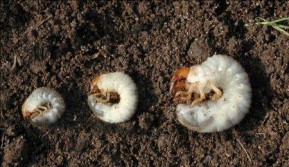White grubs: pests of strawberry roots and foliage
White grub refers to the larvae of scarab beetles, including the Japanese beetle (Popillia japonica), European chafer (Amphimallon majalis), and May and June beetles (Phyllophaga spp. and Cotinis spp.). They all have similar appearance and damage symptoms, which can include feeding on strawberry roots, causing wilting of the plant. Typically, white grubs cause significant damage in strawberries following planting in a field that had previously been planted in grasses, which is a preferred food-source. Many species of white grub adults also feed on the leaves of strawberry plants, although typically not extensively enough to cause economically significant damage.
Description and Damage: White grub larvae are thick and fleshy. Their color ranges from grey to white, with a brown head capsule. Although the size depends on species and age, mature larvae tend to be around ¾” to 1½” long. The larvae of all white grub species form a distinctive, curled-up c-shape in the soil. Unlike strawberry root weevil, which also feeds on strawberry roots causing wilting and plant die-back, white grub larvae have obvious legs.

White grub larvae feed on strawberry roots. Typically damage symptoms of white grub feeding include sudden plant wilting and die-back. Often, this will take place in the year following strawberry planting, and will begin with a single plant and then spread to surrounding areas. Roots are typically fed on and then shorn off about an inch or two below the soil surface. In addition to leading directly to reduced plant vigor, white grub feeding can also provide an opening for pathogens.
Adult white grubs are beetles, ranging from ½” to 1½” long. Their coloration varies by species. Japanese beetle adults are a distinctive shiny green/bronze color, and can cause significant damage to the foliage of strawberries and other fruit crops (see article in the previous issue of this newsletter). Rose chafer adults are a sandy tan color with long legs (see WFN Volume 2, Issue 6, page 7). May and June beetles are typically dark brown, with thick-set bodies.
Life Cycle: Many white grub species, including May and June beetles, have a three-year life cycle, in which larvae feed for nearly three years before emerging as adults. Adults will fly for several months in May and June. In those species, larval feeding damage may occur any time during the summer, as there will always be some individuals in the larval stage in any year. Other species, such as Japanese beetle, complete their development in a single year, with larvae present from late summer to the following spring, and adults flying in the summer from approximately July through August. All white grub species overwinter as larvae.
Monitoring and control: Monitoring for white grubs is recommended if there are wilting symptoms, or if you are planting strawberries where grass used to grow. Check for white grubs by digging near the wilting plants’ roots and looking for the large, easy-to-spot grubs. Additionally, if a plant suddenly dies in the field, pull it up gently to check for roots – if there is a full set of roots it is likely to be a disease issue, but if the roots end after approximately 1”, it is likely caused by white grubs.
The most effective way to minimize root feeding by white grubs is to avoid planting strawberries for two years following any grasses, including livestock pastures, grass sod, or forage crops. Additionally, you can reduce both root and foliar feeding by these beetles by leaving a buffer between grassy fields and strawberry plantings. Chemical control is only recommended when three or more white grub larvae are found on average near wilting plants. Check the latest Midwest Fruit Pest Management Guide for chemical control recommendations.
This article was posted in Berries, Insects and tagged European chafer, Japanese Beetles, June beetle, White Grubs.
